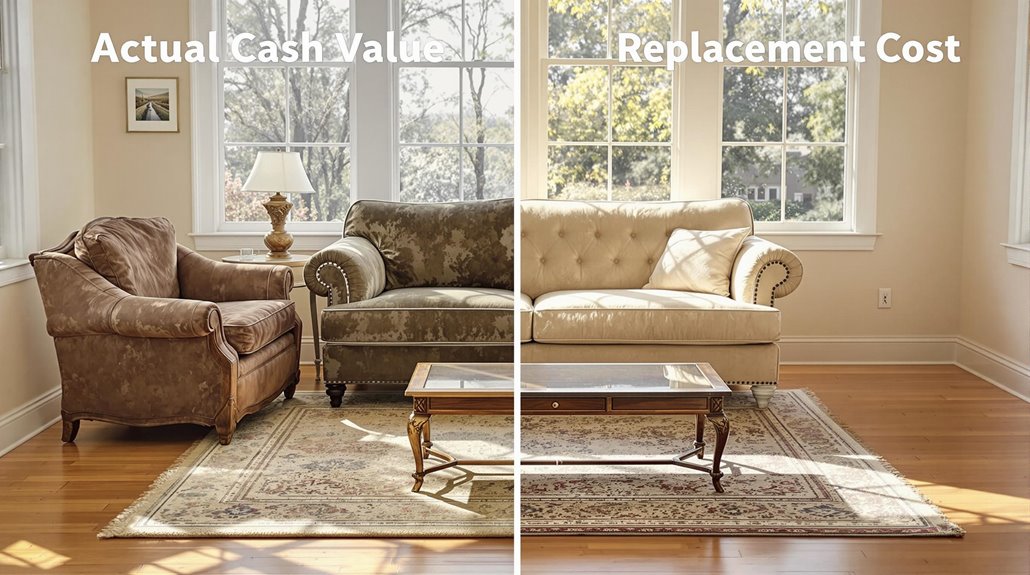Think of your homeowners insurance coverage as a protective shield with six superhero-like powers! Let's break down these essential guardians of your home:
Ever wondered what's actually covered in your policy? You've got your main star – Dwelling Coverage – protecting your house's structure, while Other Structures Coverage watches over your fence, garage, or that cute garden shed you love. Your personal belongings? They're safely tucked under Personal Property Coverage – from your comfy couch to your favorite kitchen gadgets.
But wait, there's more! What if disaster strikes and you can't live in your home? Loss of Use Coverage becomes your temporary lifestyle defender. And because life's unpredictable, Liability Protection stands ready to help if someone gets injured on your property. Medical Payments Coverage rounds out the team by handling smaller injury claims without the legal drama.
When it comes to payouts, you'll encounter two key players: Actual Cash Value (think depreciated value, like your used car) and Replacement Cost (the full price of buying new). Your choice between these options affects both your premium and how much you'll receive when filing a claim.
Want to get the most bang for your insurance buck? Understanding these coverage components is like having a roadmap to financial security. You wouldn't drive a car without knowing how the brakes work, right? Same goes for your home insurance – knowing your coverage inside and out helps you sleep better at night!
Key Takeaways
- Homeowners insurance coverage includes distinct components like Dwelling, Other Structures, Personal Property, Loss of Use, Liability, and Medical Payments.
- Coverage limits impact overall protection, and understanding these limits maximizes the benefits of homeowners insurance.
- Actual Cash Value and Replacement Cost are two types of coverage, with the latter paying for replacement without considering depreciation.
- Property coverage includes Coverage A for the house, Coverage B for detached structures, and Coverage C for personal possessions.
- Liability coverage protects against legal responsibilities for property damage or bodily injury, with limits ranging from $100,000 to $1 million.
Overview of Homeowners Insurance Coverage
While homeowners insurance coverage is often viewed as a single entity, it is actually a multifaceted policy comprised of distinct components that work together to provide extensive protection for homeowners.
A standard homeowners insurance policy typically includes several key parts:
- Dwelling coverage (Coverage A), which protects the structure of the home;
- Other Structures (Coverage B), which covers detached structures;
- Personal Property (Coverage C), which insures belongings inside and outside the home;
- Loss of Use (Coverage D), which provides financial assistance for additional living expenses;
- Liability coverage (Coverage E), which protects homeowners from legal claims arising from injuries or property damage;
- Medical Payments (Coverage F).
Each component has specific coverage limits, and understanding these limits is essential to maximizing the benefits of a homeowners insurance policy.
Working with public adjusters can help homeowners secure settlements up to 700% higher than handling claims independently.
Understanding Actual Cash Value vs. Replacement Cost

Homeowners seeking to optimize their insurance coverage must grasp a fundamental distinction between two valuation methods: Actual Cash Value (ACV) and Replacement Cost. ACV represents the current market value of an item at the time of loss, calculated as its replacement cost minus depreciation. In contrast, Replacement Cost coverage pays the actual expense to replace a damaged or destroyed item, disregarding depreciation. Extended replacement cost provides an additional 10-50% coverage beyond standard dwelling limits to protect against unexpected rebuild expenses.
| Coverage Type | Actual Cash Value | Replacement Cost |
|---|---|---|
| Dwelling (A) | Replacement cost minus depreciation | Actual replacement cost |
| Other Structures (B) | Replacement cost minus depreciation | Actual replacement cost |
| Personal Property (C) | Standard, but upgrade available | Not always available |
Choosing Replacement Cost coverage may increase premiums, but provides more thorough financial protection for homeowners. Understanding the differences between these valuation methods is essential for evaluating coverage adequacy and potential out-of-pocket expenses.
Property Coverage: Coverage Parts A, B, and C

A homeowners insurance policy typically comprises multiple components that work together to provide extensive protection for a property.
Coverage A, Dwelling, protects the house and attached structures from various perils, excluding damages from earthquakes, floods, and maintenance issues.
Coverage B, Other Structures, insures detached structures like garages, sheds, and fences against damages from covered events.
Coverage C, Personal Property, covers possessions both at home and away, operating on a named peril basis, with limitations for high-value items that may require additional scheduling.
Understanding the specific exclusions and limitations for each coverage part is essential, as they can impact the overall protection provided by the homeowners insurance policy.
Coverage types A and B may offer either actual cash value or replacement cost options, while Coverage C is typically provided on an actual cash value basis.
Policyholders should carefully review their insurance policies to guarantee they have adequate protection for their property and personal belongings.
Public adjusters can assist homeowners in navigating complex claims and ensuring fair settlements for covered damages.
Loss of Use Coverage and Its Importance

Displacement due to a covered peril can impose significant financial burdens on households.
Loss of Use coverage, also known as Coverage D, provides financial support for additional living expenses when a home becomes uninhabitable due to a covered peril, such as fire or storm damage. This coverage can pay for temporary housing, meals, and transportation costs that exceed normal living expenses during the repair period.
To be eligible for Loss of Use coverage, the event causing the displacement must be covered by the homeowner's insurance policy. Homeowners must keep detailed documentation of their additional expenses to guarantee proper reimbursement.
The extent of Loss of Use coverage varies by policy, so it's essential for homeowners to review their coverage limits and conditions with their insurance agent. By understanding Loss of Use coverage, homeowners can mitigate the financial impact of displacement and guarantee a smoother recovery process.
Coverage limits and documentation requirements must be carefully reviewed.
Working with public adjusters can help increase insurance claim settlements by up to 50% for covered losses.
Liability and Medical Payments Coverage: Coverage Parts E and F

How would unforeseen events affecting others impact one's financial stability? In the context of homeowners insurance policies, liability and medical payments coverage play a significant role in mitigating such risks. Coverage E: Personal Liability provides protection against legal responsibilities for property damage or bodily injury caused to others, including defense costs and financial judgments from covered incidents. Coverage F: Medical Payments offers rapid reimbursement for minor medical expenses incurred by guests injured on the policyholder's property. Public insurance adjusters can help maximize claims when liability disputes arise.
| Coverage | Description |
|---|---|
| Coverage E | Personal Liability for bodily injury or property damage |
| Coverage F | Medical Payments for minor medical expenses |
| Liability Limits | $100,000 to $1 million, with higher limits available |
| Exclusions | Intentional injuries, business-related incidents, athletic events |
| Purpose | Mitigate financial risks from unforeseen events |
Understanding the nuances of liability and medical payments coverage is essential in ensuring adequate protection under a homeowners insurance policy.
Exclusions and Limitations in Homeowners Insurance Policies

While homeowners insurance provides extensive protection against various risks and unforeseen events, understanding its exclusions and limitations is essential for policyholders to guarantee adequate coverage. Many standard policies may not cover specific risks, such as natural disasters like floods or earthquakes, which can lead to significant financial loss if not addressed. To bridge these gaps, homeowners should consider additional coverages in homeowners insurance, such as endorsements or riders tailored to their unique needs. By being proactive and informed about these options, homeowners can ensure they have the comprehensive protection required for their peace of mind.
Homeowners insurance typically excludes damages resulting from natural disasters, such as floods and earthquakes, unless separate policies or endorsements are purchased. Maintenance issues, including damage due to neglect or lack of upkeep, are also generally excluded from coverage, highlighting the importance of regular maintenance and repairs.
Additionally, intentional damage and damage caused by pests are not covered. Policy limits also dictate the maximum payout for claims, and exceeding these limits may result in financial loss for the homeowner. Coverage limits may need to be adjusted periodically to reflect changes in property value or other risk factors.
Policyholders must carefully review their homeowners insurance policy to understand these exclusions and limitations, ensuring they are adequately protected against potential risks and damages.
Navigating Homeowners Insurance Claims and Coverage Options

What happens when homeowners experience unforeseen property damage, and what role do insurance claims play in the recovery process? A homeowners insurance policy provides financial protection against property damage, but the extent of coverage depends on the type of policy and coverage limits.
The claims process involves documentation of damage and expenses, with payouts influenced by the type of coverage selected.
To navigate the claims process effectively, homeowners should consider the following:
- Coverage limits play a critical role in determining the maximum payout for any claim, and policyholders should verify their coverage limits align with the current value of their property and belongings.
- Different types of home insurance, such as actual cash value or replacement cost coverage, impact the payout amount.
- Homeowners should be aware of exclusions in their policies, such as damages from floods or maintenance issues, which may necessitate additional coverage or endorsements for thorough protection.
The Benefits Of Consulting A Public Adjuster

Consulting a public adjuster can provide homeowners with distinct advantages in the claims process.
A public adjuster's expertise in insurance claims allows for objective damage assessments and a more streamlined claim process, reducing the complexity and time required to reach a settlement.
Expertise In Insurance Claims
Maneuvering the complexities of insurance claims requires a deep understanding of policy terms, conditions, and applicable laws. Homeowners managing the claims process often benefit from consulting a public adjuster, who possesses expertise in insurance claims.
A public adjuster's extensive knowledge of insurance policies enables them to identify all applicable coverages, ensuring that policyholders maximize their claim amount for damages.
Key benefits of a public adjuster's expertise in insurance claims include:
- Identifying and applying all relevant policy coverages to maximize the claim amount
- Providing thorough documentation to support the claim and expedite the claims process
- Negotiating with the insurance company to secure a fair settlement based on the policyholder's coverage, ensuring they receive adequate compensation for damage to property
Objective Damage Assessment
The accuracy of a damage assessment plays an essential role in determining the outcome of a homeowners insurance claim. A public adjuster can provide an objective damage assessment, guaranteeing that all damage to the house is properly documented and accounted for.
This is vital, as the homeowners insurance policy includes coverage that will pay for specific types of damage. A public adjuster's expertise can also help identify expenses while the home is being repaired or rebuilt.
Streamlined Claim Process
Homeowners seeking to maximize their insurance claim payouts can benefit greatly from the expertise of a public adjuster, particularly in streamlining the claims process.
A public adjuster's primary role is to advocate on behalf of the policyholder, guaranteeing that all covered losses are accurately documented and submitted to the insurance company. This expertise can lead to a more efficient claims process, ultimately resulting in higher claim payouts.
- The public adjuster handles all communication with the insurance company, minimizing the policyholder's stress and time commitment.
- Accurate documentation of covered losses guarantees that the policyholder receives fair compensation for damages.
- The public adjuster's expertise in policy coverage and negotiation tactics often results in higher claim payouts compared to handling claims independently.
Higher Claim Payouts & Settlements
Engaging the services of a public adjuster can be a pivotal decision for policyholders seeking to maximize their claim payouts. Studies have shown that policyholders who hire public adjusters receive, on average, 20% to 50% more than those who file claims independently. Public adjusters are licensed professionals who understand the complexities of homeowners insurance policies, ensuring that all damages are accurately documented and valued in the claim process.
| Benefits of Public Adjuster | Percentage Increase | Additional Settlement |
|---|---|---|
| Average increase in claim payout | 20% to 50% | Up to $50,000 |
| Increase in claims processed efficiently | 30% to 60% | Up to $75,000 |
| Policyholders who hire public adjusters | 90% satisfaction rate | Maximum compensation |
About The Public Claims Adjusters Network (PCAN)

When traversing the complexities of residential and commercial property damage insurance claims, policyholders often require expert guidance to guarantee fair compensation.
The Public Claims Adjusters Network (PCAN) serves as a resource for policyholders to connect with expert public adjusters who specialize in residential and commercial property damage insurance claims. These public adjusters are pre-vetted, licensed, and experts in their field, covering over 30 different claim types and located in 40+ states.
Key aspects of the Public Claims Adjusters Network (PCAN) include:
- Member adjusters are held to the highest standards of ethics, morals, and professionalism, with mandatory yearly audits of their licenses and any complaints.
- PCAN acts as a resource for the top public adjusters around the nation, connecting them with policyholders who need their assistance in maneuvering homeowners policy claims and ensuring fair compensation for damage to property and personal belongings.
- Public adjusters in the PCAN are considered to be the best-of-the-best, and must go through an intensive application & interview process to be admitted.
Frequently Asked Questions
What Does Coverage a Insurance Mean in a Homeowners Policy?
A shield for one's castle, Coverage A in a homeowners policy protects the physical structure, with coverage limits reflecting home value, subject to policy exclusions, and influencing types of coverage, claim process, premium costs, and coverage adjustments.
What Does Coverage Mean in Insurance?
In insurance, "coverage" refers to the scope of protection against specific risks, including limits of liability, exclusionary clauses, and risk assessment considerations that impact policy costs and claims, ultimately influencing liability protection and premium amounts.
What Does 80% Insurance Coverage Mean?
Eighty percent insurance coverage requires a homeowner's policy limits to be at least 80% of the dwelling's replacement cost, influencing premium calculations and risk assessment, while minimizing coverage gaps and their impact on deductible amounts and insurance claims.
What Coverage a Refers to in Homeowners Insurance Coverage?
A shield envelops the physical home structure, symbolizing dwelling protection. Coverage A safeguards against loss, with insurance limits mirroring property value. Exclusions and risk assessment influence the claim process, emphasizing the importance of adequate policy limits.








